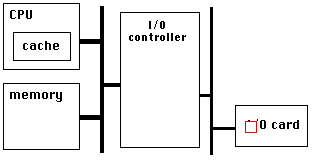In 2007 AMD implemented an I/O MMU in their system architecture, which translates DMA addresses from peripheral devices to a different address on the system bus. There were several motivations for doing this:
- Virtualization: DMA can be restricted to memory belonging to a single VM and to use the addresses from that VM, making it safe for a driver in that VM to take direct control of the device. This appears to be the largest motivation for adding the IOMMU.
- High Memory support: For I/O buses using 32 bit addressing, system memory above the 4GB mark is inaccessible. This has typically been handled using bounce buffers, where the hardware DMAs into low memory which the software will then copy to its destination. An IOMMU allows devices to directly access any memory in the system, avoiding copies. There are a large number of PCI and PCI-X devices limited to 32 bit DMA addresses. Amazingly, a fair number of PCI Express devices are also limited to 32 bit addressing, probably because they repackage an older PCI design with a new interface.
- Enable user space drivers: A user space application has no knowledge of physical addresses, making it impossible to program a DMA device directly. The I/O MMU can remap the DMA addresses to be the same as the user process, allowing direct control of the device. Only interrupts would still require kernel involvement.

I/O Device Latency
 PCIe has a very high link bandwidth, making it easy to forget that its position in the system imposes several levels of bridging with correspondingly long latency to get to memory. The PCIe transaction first traverses the Northbridge and any internal switching or bus bridging it contains, on its way to the processor interconnect. The interconnect is HyperTransport for AMD CPUs, and QuickPath for Intel. Depending on the platform, the transaction might have to travel through multiple CPUs before it reaches its destination memory controller, where it can finally access its data. A PCIe Read transaction must then wend its way back through the same path to return the requested data.
PCIe has a very high link bandwidth, making it easy to forget that its position in the system imposes several levels of bridging with correspondingly long latency to get to memory. The PCIe transaction first traverses the Northbridge and any internal switching or bus bridging it contains, on its way to the processor interconnect. The interconnect is HyperTransport for AMD CPUs, and QuickPath for Intel. Depending on the platform, the transaction might have to travel through multiple CPUs before it reaches its destination memory controller, where it can finally access its data. A PCIe Read transaction must then wend its way back through the same path to return the requested data.

Much lower latency comes from sitting directly on the processor bus, and there have been systems where I/O devices sit directly beside CPUs. However CPU architectures rev that bus more often than it is practical to redesign a horde of peripherals. Attempts to place I/O devices on the CPU bus generally result in a requirement to maintain the "old" CPU bus as an I/O interface on the side of the next system chipset, to retain the expensive peripherals of the previous generation.
The Missed Opportunity: DMA Read pipelining
An IOMMU is not a new concept. Sun SPARC, some SGI MIPS systems, and Intel's Itanium all employ them. Once you have taken the plunge to impose an address lookup between a DMA device and the rest of the system, there are other interesting things you can do in addition to remapping. For example, you can allow the mapping to specify additional attributes for the memory region. Knowing whether it is likely to do long, contiguous bursts or short concise updates allows optimizations to reduce latency by reading ahead, to transfer data faster by pipelining.
| Without prefetch (CONSISTENT) | With prefetch (STREAMING) |
 |
 |
AMD's IOMMU includes nothing like this. Presumably they wanted to confine the software changes to the Hypervisor alone, whilst choosing STREAMING versus CONSISTENT requires support in the driver of the device initiating DMA, but they could have ensured software compatibility by making CONSISTENT be the default with STREAMING only used by drivers which choose to implement it.
What About Writes?
The IOMMU in SPARC systems implemented additional support for DMA write operations. Writing less than a cache line is inefficient, as the I/O controller has to fetch the entire line from memory and merge the changes before writing it back. This was a problem for Sun, which had a largish number of existing SBus devices issuing 16 or 32 byte writes while the SPARC cache line had grown to 64 bytes. A STREAMING mapping relaxed the requirement for instantaneous consistency: if a burst wrote the first part of a cache line, the I/O controller was allowed to buffer it in hopes that subsequent DMA operations would fill in the rest of the line. This is an idea whose time has come... and gone. The PCI spec takes great care to emphasize cache line sized writes using MWL or MWM, an emphasis which carries over the PCIe as well. There is little reason now to design coalescing hardware to optimize sub-cacheline writes.
| Without buffering (CONSISTENT) | With buffering (STREAMING) |
 |
 |
Closing Disclaimer
Maybe I'm way off base in lamenting the lack of DMA read pipelining. Maybe all relevant PCIe devices always issue Memory Read Multiple requests for huge chunks of data, and the chipset already pipelines data fetch during such large transactions. Maybe. I doubt it, but maybe...